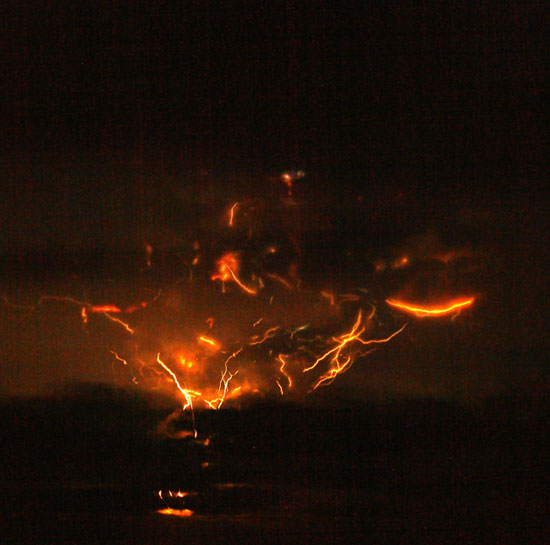Dramatic Image Shows Volcano's Lightning

For the first time, scientists have been able to “see” and trace lightning inside a plume of ash spewing from an actively erupting volcano.
When Alaska's Mount Redoubt volcano began rumbling back to life in January, a team of researchers scrambled to set up a system called a Lightning Mapping Array that would be able to peer through the dust and gas of any eruption that occurred to the lightning storm happening within. Lightning is known to flash in the tumultuous clouds belched out during volcanic eruptions.
The lightning produced when Redoubt finally erupted on March 22 was "prolific," said physicist Paul Krehbiel of New Mexico Tech. Check out the image.
"The lightning activity was as strong or stronger than we have seen in large Midwestern thunderstorms," Krehbiel said. "The radio frequency noise was so strong and continuous that people living in the area would not have been able to watch broadcast VHF television stations."
Lightning mapping arrays are increasingly being used by meteorologists to issue weather warnings, but have only been deployed at volcanoes twice before.
Thousands of individual segments of a single lightning stroke can be mapped with these arrays, and later analyzed to reveal how lightning initiates and spreads through a thunderstorm, or in a volcanic plume.
After setting up the arrays, researchers waited nearly two months for Redoubt's first eruption, but the wait was worth it.
Sign up for the Live Science daily newsletter now
Get the world’s most fascinating discoveries delivered straight to your inbox.
"For the first time, we had the Lightning Mapping Array on site before the initial eruption," said scientist Sonja Behnke of New Mexico Tech.
The eruptions that continued to occur on March 22 and 23 provided plenty of data, and the arrays returned dramatic information about the electricity created within volcanic plumes, and the resulting lightning. As of today, Redoubt has erupted several times since its initial eruption on March 22.
"The data will allow us to better understand the electrical charge structure inside a volcanic plume," said scientist Ron Thomas of New Mexico Tech. "That should help us learn how the plume is becoming electrified, and how it evolves over time."
A recent study in the journal Nature found that volcanic plumes spin like tornadic thunderstorms, a finding which helps to explain the lightning storms, as well as the waterspouts and dust devils produced by some volcanic plumes.
The New Mexico Tech researchers plan to compare the Redoubt data with observations taken from Chaiten Volcano in Chile last year. The project was funded by the National Science Foundation.
Redoubt hasn't finished making noise yet; after quieting down for a few days, Redoubt exploded again, with the last major eruption occurring on March 28. Scientists at the Alaska Volcano Observatory expect the eruptions will continue periodically for weeks to months.
- Volcano Quiz: Part 1, Part 2
- Images: Lightning Strikes
- Volcano News, Information and Images
{{ video="LS_090323_Redoubt" title="The Restive Redoubt Volcano" caption="The Redoubt Volcano, which erupted several times since March 22, 2009, is seen here on Feb. 7, 2009." }}

Andrea Thompson is an associate editor at Scientific American, where she covers sustainability, energy and the environment. Prior to that, she was a senior writer covering climate science at Climate Central and a reporter and editor at Live Science, where she primarily covered Earth science and the environment. She holds a graduate degree in science health and environmental reporting from New York University, as well as a bachelor of science and and masters of science in atmospheric chemistry from the Georgia Institute of Technology.









